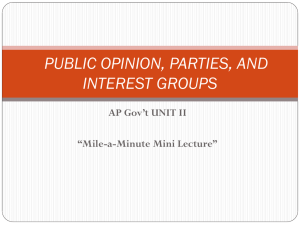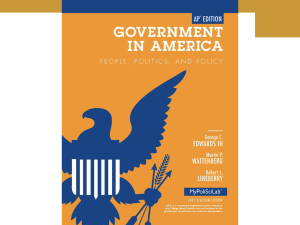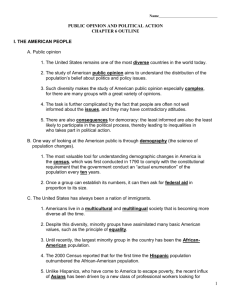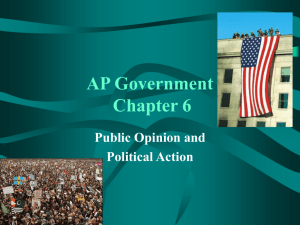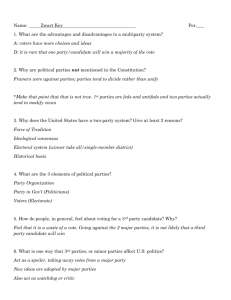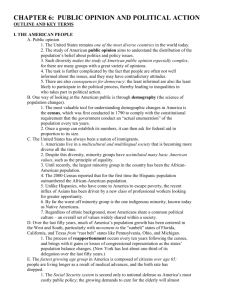Chapter 6: Public Opinion & Political Action (pp 172-206) Case Name:
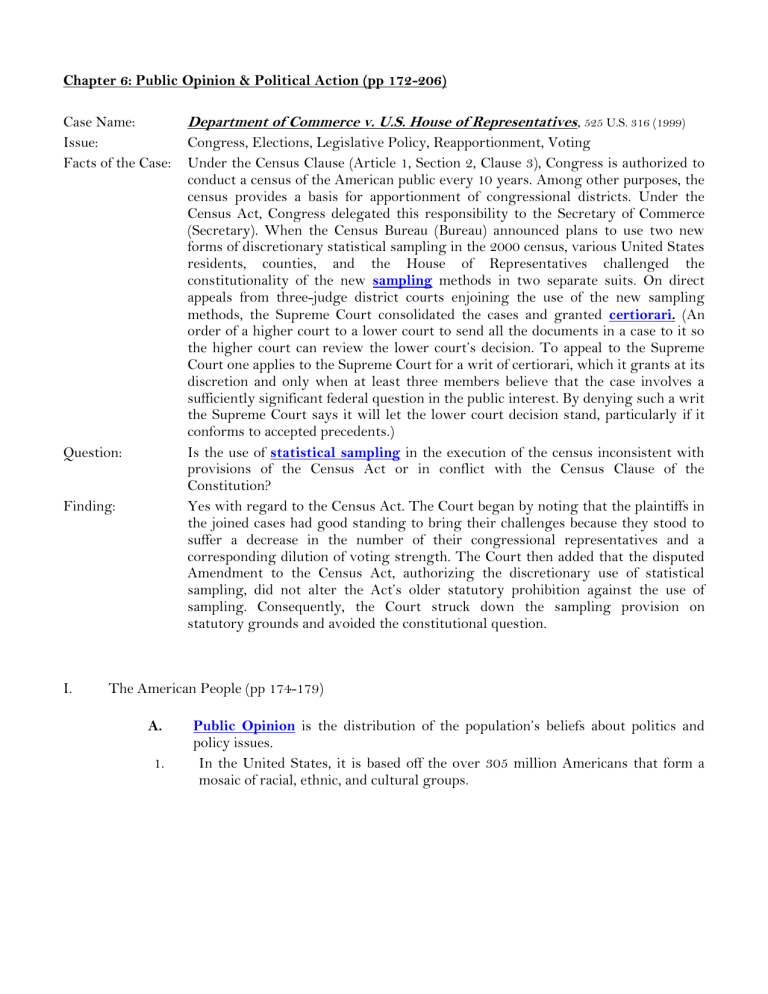
I.
Chapter 6: Public Opinion & Political Action (pp 172-206)
Case Name:
Issue:
Department of Commerce v. U.S. House of Representatives , 525 U.S. 316 (1999)
Congress, Elections, Legislative Policy, Reapportionment, Voting
Facts of the Case: Under the Census Clause (Article 1, Section 2, Clause 3), Congress is authorized to conduct a census of the American public every 10 years. Among other purposes, the census provides a basis for apportionment of congressional districts. Under the
Census Act, Congress delegated this responsibility to the Secretary of Commerce
(Secretary). When the Census Bureau (Bureau) announced plans to use two new forms of discretionary statistical sampling in the 2000 census, various United States residents, counties, and the House of Representatives challenged the constitutionality of the new sampling methods in two separate suits. On direct appeals from three-judge district courts enjoining the use of the new sampling methods, the Supreme Court consolidated the cases and granted certiorari .
(An order of a higher court to a lower court to send all the documents in a case to it so the higher court can review the lower court’s decision. To appeal to the Supreme
Court one applies to the Supreme Court for a writ of certiorari, which it grants at its discretion and only when at least three members believe that the case involves a sufficiently significant federal question in the public interest. By denying such a writ the Supreme Court says it will let the lower court decision stand, particularly if it conforms to accepted precedents.)
Question: Is the use of statistical sampling in the execution of the census inconsistent with provisions of the Census Act or in conflict with the Census Clause of the
Constitution?
Finding: Yes with regard to the Census Act. The Court began by noting that the plaintiffs in the joined cases had good standing to bring their challenges because they stood to suffer a decrease in the number of their congressional representatives and a corresponding dilution of voting strength. The Court then added that the disputed
Amendment to the Census Act, authorizing the discretionary use of statistical sampling, did not alter the Act’s older statutory prohibition against the use of sampling. Consequently, the Court struck down the sampling provision on statutory grounds and avoided the constitutional question.
The American People (pp 174-179)
A.
Public Opinion is the distribution of the population’s beliefs about politics and policy issues.
1.
In the United States, it is based off the over 305 million Americans that form a mosaic of racial, ethnic, and cultural groups.
2.
3.
4.
Chapter 6 Notes
Page 2 of 11
Involves interviewing procedures and careful wording of questions.
The task is further complicated because people are often not well informed about the issues, and they may have contradictory attitudes. MOST issues do NOT attract the attention of even a majority of citizens.
There are also consequences for democracy: the least informed are also the least likely to participate in the political process, thereby leading to inequalities in who takes part in political action.
B.
Demography (the science of population changes) is one way of looking at the
American public.
1.
The most valuable tool for understanding demographic changes in America is the census , which was first conducted in 1790 to comply with the constitutional requirement that the government conduct an “actual enumeration” of the population every ten years.
2.
3.
Once a group can establish its numbers, it can then ask for federal aid (formula grants) to the states in proportion to its size.
Department of Commerce v. U.S. House of Representatives (1999) established that the sampling could not be used to determine the number of congressional districts each state is entitled to; however, sampling could be used for purposes of allocating federal grants to states.
C.
The Immigrant Society (pp. 174-179)
1.
With its long history of immigration, the United States has often been called a melting pot referring to a mixture of cultures, ideas, and peoples.
2.
3.
4.
5.
Chapter 6 Notes
Page 3 of 11
Federal law allows up to 800,000 new immigrants to be legally admitted to the country every year; however, in recent years, illegal immigrants have outnumbered legal immigrants.
Policymakers have begun to speak of a new minority majority meaning that America will eventually cease to have a White, generally Anglo-
Saxon majority
(currently 69%). a) The 2000
Census reported that for the first time the Hispanic population (13%) outnumbered the African-
American population (12%). b) Unlike Hispanics who have come to America to escape poverty, the recent influx of Asians (4%) has been driven by a new class of professional workers looking for greater opportunity. c) By far the worst off (least healthy, poorest, and least educated) minority group is the one indigenous minority, known today as Native Americans
(less than 1%).
Simpson-Mazzoli Act of 1986 requires employers to document the citizenship of their employees. a) Regardless of birthplace (within or outside the U.S.), people must prove that they are either U.S. citizens or legal immigrants in order to work. b) Because the Act has done little to stop illegal immigration, proposed solutions (i.e., California’s 1994 initiative Proposition 187 which was deemed unconstitutional) denying all benefits (including public school and medical assistance) from government programs to people who cannot prove that they are legal residents of the U.S. have been suggested.
Regardless of ethnic background most Americans share a common political culture (an overall set of values widely shared within a society) such as the principle of treating all equally.
D.
Regional Shift (pg. 179)
1.
Over the last fifty years, much of America’s population growth has been centered in the West and South, particularly with movement to the “sunbelt” states of
Florida, California, and Texas from “rust belt” states like Pennsylvania, Ohio, and
Michigan.
2.
The process of reapportionment occurs every ten years following the census, and brings with it reallocation (gains or losses) of the 435 congressional seats as the
Chapter 6 Notes
Page 4 of 11 states’ population balance changes. (New York has lost about one-third of its delegation over the last fifty years.)
E.
Graying of America (pg. 179)
1.
Florida, one of the three mega states, has grown in large part as a result of its attractiveness to senior citizens.
2.
3.
The fastest growing age group in America is composed of citizens over age 65: people are living longer as a result of medical advances, and the birth rate has dropped.
The Social Security System is second only to national defense as America’s most costly public policy (by 2020 the cost will be $5 trillion); the growing demands to care for the elderly will almost certainly become more acute in the decades ahead.
II.
How Americans Learn About Politics: Political Socialization
A.
Political Socialization is the process through which an individual acquires his or her own political orientations – his or her knowledge, feelings, and evaluations regarding his or her political world.
B.
Agents of Political Socialization
1.
Family is central because of its monopoly on two crucial resources in the early years – time and emotional commitment. a) One can predict how the majority of young people will vote simply by knowing the political leanings of their parents. b) Moving out of the family nest and into adulthood does promote changes in political ideology. c) Age-Cohort Tendency (a.k.a Cohort Effect a.k.a Generation Gap ) – the tendency for a significant break in the pattern of political socialization to occur among younger citizens, usually as the result of a major event or development that disrupts preexisting beliefs.
(1) Example: FDR’s New Deal that alleviated economic hardship of the
Great Depression prompted young Republicans to become
Democrats.
(2) Example: Young men of draft age during war.
Chapter 6 Notes
Page 5 of 11
2.
3.
4.
5.
6.
Mass Media is the “new parent” for socializing young adults in politics.
a) Average grade-school student spends more time each week watching television than they spend at school. b) Television (not including newscasts) now displaces parents as the chief source of information. c) The typical viewer of the major national newscasts is 58 years old.
School is used to promote national loyalty and support for its basic values.
a) Ensures that students learn the positive features of their political system to grow up to be supportive citizens. b) Better-educated citizens are more likely to vote in elections, they exhibit more knowledge about politics and public policy, and they are more tolerant of opposing (even radical) opinions.
Peer Groups generally reinforce what a persona already believes.
Political Institutions and Leaders are looked upon by citizens to be a guide regarding national issues. Post 9/11 speech by George W. Bush had 9 out of 10
Americans sharing his views.
Church has played a substantial role in shaping Americans’ social and political opinions. Many believe that religion has the answers to problems facing today’s society.
C.
Politics is a Lifelong Activity (pg. 183) – political participation rises steadily with age as does the strength of party identification/attachment.
D.
Life Cycle Effects are changes in opinions or patterns of behavior that occur among most people at major point of their life like marriage, parenthood, or retirement
E.
Period Effects have the potential to change the political thinking of people of all ages and positions within society.
Chapter 6 Notes
Page 6 of 11
III.
What Americans Value: Political Ideologies (pp. 192-195)
A.
Political ideology is a coherent set of values and beliefs about public policy.
B.
Who are the liberals and conservatives?
1.
Overall, more Americans consistently choose the ideological label of conservative over liberal. a) c)
Liberals – Those who believe government should do more to solve the nation’s problems but reject the notion that government should favor a particular set of social values. b) Conservatives – Those who believe government tries to do many things that should be left to firms and individuals but look to government to uphold traditional values.
Libertarians – Those who believe government tries to do too many things that should be left to firms and individuals and who oppose government as an instrument of traditional values.
2.
3.
d) Populists – Those who believe government should do more to solve the nation’s problems and who look to it to uphold traditional values.
Some groups are more liberal than others, and want to see government do more; this includes people under the age of 30, minorities, and women.
Groups with political clout tend to be more conservative than groups whose members have often been shut out from the halls of political power
4.
5.
Gender Gap refers to the ideological difference shown in the regular pattern by which women are more likely to support Democratic candidates. a) Women are more likely to support spending on social services b) Women are more likely to oppose higher levels of military spending.
Demographics Influencing Ideology a) Social Class – The more money you make the more likely you will be conservative. b) Religion – The more religious you are the more likely you will be conservative (although most Jews are Liberal).
Chapter 6 Notes
Page 7 of 11
C.
Do people think in ideological terms?
1.
Ideological thinking is not widespread in the American public, nor are people necessarily consistent in their attitudes.
2.
The authors of the classic study American Voter first looked carefully at the ideological sophistication of the American electorate in the 1950s. They divided the public into four groups, according to ideological sophistication. a) c)
Ideologues – Only 12 percent could connect their opinions and beliefs with broad policy positions taken by parties or candidates. b) Group Benefit Voters – Forty-two percent of Americans thought of politics mainly by the groups they liked or disliked.
Nature of the Times Voters the population was limited to whether the times seemed good or bad to them.
– The “handle on politics” of 24 percent of
3.
d) No Issue Content Voters – Twenty-two percent of the voters were devoid of any ideological or issue content in their political evaluations; most simply voted routinely for a party or judged the candidates by their personalities.
If the same methods are used to update the analysis of the American Voter through the 1980s, one finds some increase in the proportion of ideologues, but the overall picture looks much the same.
IV.
Measuring Public Opinion and Political Information (pp. 183-192)
A.
Public Opinion is the distribution of the population’s beliefs about politics and policy issues. Most issues do NOT attract the attention of even a majority of citizens. But public opinion is one of the products of political learning.
1.
2.
Plurality Opinion – A large number of population that represents the greatest percent; it does not necessarily mean simple majority.
Elitist Opinion – An elite group of generally business and policy leaders with varying interests.
3.
Majority Opinion – Over half (50.1%) of the population values or supports an issue.
B.
How Polls Are Conducted (pp. 183-185)
1.
Public opinion polling was first developed by George Gallup in 1932.
Chapter 6 Notes
Page 8 of 11
2.
Polls rely on a sample (a relatively small proportion of people who are chosen as representative of the whole) of the population to measure public opinion. a) A sample of about 1,500 to 2,000 people can be representative of the
“ universe ” (the larger group whose opinion is being measured) of potential voters. b) The key to the accuracy of opinion polls is random sampling , which operates on the principle that everyone should have an equal probability of being selected. It should represent the proportional demographics within the U.S. c) The level of confidence is known as the the size of the sample. The more people interviewed in a poll, the more confident one can be of the results. sampling error , which depends on d) The most infamous survey was a 1936 Literary Digest poll that underestimated the vote for President Franklin Roosevelt by 19%. Its polling methods were badly flawed in the focus being “above income level”
– even though they polled over 2.3 million people. The moral of the story is accurate representation, not the number of responses, is the most important feature of public opinion survey.
3.
Sophisticated Technology for Measuring Public Opinion (pg. 185) a) Computer and telephone technology make surveying less expensive and more commonplace. b) Most polling is now done on the telephone with samples selected through random-digit dialing , in which calls are placed to telephone numbers
(listed and unlisted) within randomly chosen exchanges (512-471-XXXX). c) In this era of cell phones, many pollsters are starting to worry whether this methodology will continue to work much longer. There is also the issue that 7% of the population doesn’t have a phone.
C.
Role of Polls in American Democracy (pp. 185-187)
1.
Supporters of polling believe it is a tool for democracy by which policymakers can keep in touch with changing opinions on issues.
2.
Critics of polling think it makes politicians more concerned with following than leading and may thus discourage bold leadership.
3.
4.
5.
Recent research by Jacobs and Shapiro argues that politicians track public opinion to determine how to craft their public presentations and win support by using keywords and phrases with which to “sell” policies.
Polls can weaken democracy by distorting the election process; polls are often accused of creating a “ bandwagon effect ,” in which voters may support a candidate only because they see that others are doing so.
The election-day exit poll is probably the most-criticized type of poll. Because the results are accumulated and then broadcast as the East Coast polls close and the
6.
Chapter 6 Notes
Page 9 of 11
West Coast still has hours to vote, it creates “ time zone fallout ” (discouraging people from voting thereby affecting the outcome of some state and local races).
Perhaps the most pervasive criticism of polling is that pollsters can get pretty much the results they want by altering the wording of questions. Although the bias in such questions may be easy to detect, the ethical problem is that an organization may not report how the survey questions were worded.
D.
What Polls Reveal about Americans’ Political Information
1.
Polls have revealed again and again that the average American has a low level of political knowledge. a) In the 1996 National Election Study, only 88 percent knew that was president of Russia; 59 percent knew that Newt Gingrich was the speaker of the house; and 10 percent knew that William Rehnquist was chief justice of the Supreme Court.
2.
3.
b) Surveys also show that citizens around the globe lack a basic awareness of the world around them.
Part of the reason the American political system works as well as it does is that people do know what basic values they want upheld, even when they do not have information on policy questions or decision makers.
Increased levels of education over the last four decades have scarcely raised public knowledge about politics.
Americans trust the government less today than they did in the 1960s. 4.
V.
How Americans Participate in Politics
Chapter 6 Notes
Page 10 of 11
A.
Political Participation encompasses the many activities used by citizens to influence the selection of political leaders or the policies they pursue.
1.
Conventional Participation includes many widely accepted modes of influencing government, such as a) Voting - Paradoxically, the United State has a participatory political culture, but only 51 percent of Americans voted in the 2000 presidential election, 39 percent turned out for the 2002 mid-term elections, and the numbers get even smaller for state and local elections.
2.
b) Joining Political Groups – Joining major parties, interest groups, or other entities that have political influence. c) Writing to Elected Officials either supportive or objective can impact the process in which government officials respond.
– By expressing one’s concerns over policy d) Giving Money to Political Candidates – funding of candidates campaigns can help promote the candidates success for the next election. e) Running for Political Office – there is no better way to participate in government than to join the process.
Unconventional Participation includes activities that are often dramatic, such as protesting, civil disobedience, and even violence. a) Protest is a form of political participation designed to achieve policy change through dramatic and unconventional tactics, and protests today are often orchestrated to provide television cameras with vivid images. b) Throughout American history, individuals and groups have sometimes used civil disobedience (consciously breaking a law that they think is unjust), illustrated in different eras by people like Henry David Thoreau in the 1840s and the Rev. Martin Luther King, Jr. in the 1950s and 1960s. c) Nonviolent civil disobedience was one of the most effective techniques of the civil rights movement in the American South. Rev. King’s Letter from a
Birmingham Jail is a classic defense of civil disobedience. d) Political participation can also be violent (as in some of the Vietnam war protests of the 1960s).
B.
Class, Inequality, and Participation
1.
In the United States, participation is a class-biased activity, with citizens of higher socioeconomic status participating more than others.
2.
Minority Groups like Hispanics and African-Americans are below average in terms of political participation. a) The participation differences between these groups and the national average has been declining. b) When blacks, Hispanics, and whites of equal incomes and educations are compared, it is minorities who participate more in politics.
VI.
Understanding Public Opinion and Political Action
Chapter 6 Notes
Page 11 of 11
A.
Public attitudes toward the scope of government.
1.
The question of government power is a complex one, but it is one of the key controversies in American politics today. a) Public opinions on different aspects of the same issue do not always hold together well: while more people today think the government is too big rather than too small, a plurality has consistently called for spending on programs like education, healthcare, aid to big cities, protecting the environment, and fighting crime. b) Many political scientists have looked at these contradictory findings and concluded that Americans are ideological conservatives but operational liberals.
B.
Democracy, public opinion, and political action
1.
Americans often take for granted the opportunity to replace our leaders at the next election.
2.
Perhaps the best indicator of how ell socialized Americans are to democracy is that protest typically is aimed at getting the attention of government, not at overthrowing it.
3.
Even if they are only voting according to the nature of the times, voters are clearly being heard, which holds elected officials accountable for their actions.
Easy Issues – Issues like those dealing with race, abortion, international crises involving American troops, where citizens find it easy to make gut-level commitments requiring little detailed information or ideological context.
Hard Issues – Issues that require people to have a good deal of background information, an appreciation for the details of possible policy options, and a clear ideological framework within which to place the issues in order to understand the issue and form an opinion on it. Most issues are hard issues.
Primary Groups – Face-to-face groups, such as families and friends, with which the individual has regular, often continuous, contact.
Secondary Groups – Broader and more diffuse than primary groups, secondary groups often serve a particular role or purpose in the life of the members and often do not meet together as an entire membership.
Social Class – Broad divisions in society such as lower, working, middle, and upper, based on income and related socioeconomic strata.
